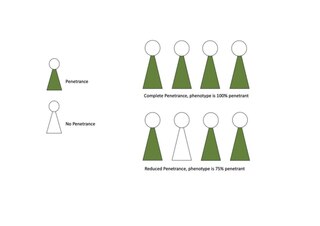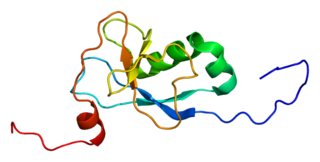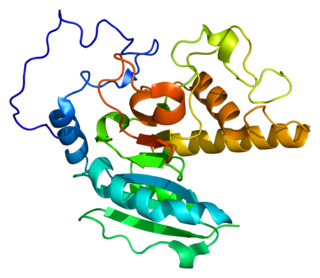Related Research Articles

Dyslexia, previously known as word blindness, is a learning disability that affects either reading or writing. Different people are affected to different degrees. Problems may include difficulties in spelling words, reading quickly, writing words, "sounding out" words in the head, pronouncing words when reading aloud and understanding what one reads. Often these difficulties are first noticed at school. The difficulties are involuntary, and people with this disorder have a normal desire to learn. People with dyslexia have higher rates of attention deficit hyperactivity disorder (ADHD), developmental language disorders, and difficulties with numbers.

Penetrance in genetics is the proportion of individuals carrying a particular variant of a gene (genotype) that also expresses an associated trait (phenotype). In medical genetics, the penetrance of a disease-causing mutation is the proportion of individuals with the mutation that exhibit clinical symptoms among all individuals with such mutation. For example: If a mutation in the gene responsible for a particular autosomal dominant disorder has 75% penetrance, then 75% of those with the mutation will go on to develop the disease, showing its phenotype, whereas 25% will not.

UK Biobank is a large long-term biobank study in the United Kingdom (UK) which is investigating the respective contributions of genetic predisposition and environmental exposure to the development of disease. It began in 2006. UK Biobank has been cited as an important resource for cancer research.
Nutritional genomics, also known as nutrigenomics, is a science studying the relationship between human genome, human nutrition and health. People in the field work toward developing an understanding of how the whole body responds to a food via systems biology, as well as single gene/single food compound relationships. Nutritional genomics or Nutrigenomics is the relation between food and inherited genes, it was first expressed in 2001.

Ian John Deary OBE, FBA, FRSE, FMedSci is a Scottish psychologist known for work in the fields of intelligence, cognitive ageing, cognitive epidemiology, and personality.

Doublecortin domain-containing protein 2 (DCDC2) is a protein that in humans is encoded by the DCDC2 gene.
The study of height and intelligence examines correlations between human height and human intelligence. Some epidemiological research on the subject has shown that there is a small but statistically significant positive correlation between height and intelligence after controlling for socioeconomic class and parental education. The cited study, however, does not draw any conclusions about height and intelligence, but rather suggests "a continuing effect of post-natal growth on childhood cognition beyond the age of 9 years." This correlation arises in both the developed and developing world and persists across age groups. An individual's taller stature has been attributed to higher economic status, which often translates to a higher quality of nutrition. This correlation, however, can be inverted to characterize one's socioeconomic status as a consequence of stature, where shorter stature can attract discrimination that affects many factors, among them employment, and treatment by educators. One such theory argues that since height strongly correlates with white and gray matter volume, it may act as a biomarker for cerebral development which itself mediates intelligence. Competing explanations include that certain genetic factors may influence both height and intelligence, or that both height and intelligence may be affected in similar ways by adverse environmental exposures during development. Measurements of the total surface area and mean thickness of the cortical grey matter using a magnetic resonance imaging (MRI) revealed that the height of individuals had a positive correlation with the total cortical surface area. This supports the idea that genes that influence height also influence total surface area of the brain, which in turn influences intelligence, resulting in the correlation. Other explanations further qualify the positive correlation between height and intelligence, suggesting that because the correlation becomes weaker with higher socioeconomic class and education level, environmental factors could partially override any genetic factors affecting both characteristics.

Dyslexia-associated protein KIAA0319 is a protein which in humans is encoded by the KIAA0319 gene.

Histo-blood group ABO system transferase is an enzyme with glycosyltransferase activity, which is encoded by the ABO gene in humans. It is ubiquitously expressed in many tissues and cell types. ABO determines the ABO blood group of an individual by modifying the oligosaccharides on cell surface glycoproteins. Variations in the sequence of the protein between individuals determine the type of modification and the blood group. The ABO gene also contains one of 27 SNPs associated with increased risk of coronary artery disease.
In multivariate quantitative genetics, a genetic correlation is the proportion of variance that two traits share due to genetic causes, the correlation between the genetic influences on a trait and the genetic influences on a different trait estimating the degree of pleiotropy or causal overlap. A genetic correlation of 0 implies that the genetic effects on one trait are independent of the other, while a correlation of 1 implies that all of the genetic influences on the two traits are identical. The bivariate genetic correlation can be generalized to inferring genetic latent variable factors across > 2 traits using factor analysis. Genetic correlation models were introduced into behavioral genetics in the 1970s–1980s.
Timothy C. Bates is a professor of differential psychology at the University of Edinburgh. His research interests include the genetics of reading and spelling, intelligence, and personality.
The Lothian birth-cohort studies are two ongoing cohort studies which primarily involve research into how childhood intelligence relates to intelligence and health in old age. The Lothian Birth Cohort studies of 1921 and 1936 have, respectively, followed up Lothian-based participants in the Scottish Mental Surveys of 1932 and 1947 in old age. Scottish Mental Survey data has provided a measure of the intelligence of Lothian Birth Cohort participants at age 11, which has enabled the investigation of how childhood intelligence relates to cognition, mental health and physical health in old age.

Steve Horvath is a German–American aging researcher, geneticist, and biostatistician. He is a professor at the University of California, Los Angeles known for developing the Horvath aging clock, which is a highly accurate molecular biomarker of aging, and for developing weighted correlation network analysis. His work on the genomic biomarkers of aging, the aging process, and many age related diseases/conditions has earned him several research awards. Horvath is a principal investigator at the anti-aging startup Altos Labs and co-founder of nonprofit Clock Foundation.
Wendy Johnson is an American differential psychologist and professor of psychology at the University of Edinburgh. She holds the chair in Differential Development in the Department of Psychology and Centre for Cognitive Ageing and Cognitive Epidemiology at the University of Edinburgh.
Naomi Ruth Wray is an Australian statistical geneticist at the University of Queensland, where she is a Professorial Research Fellow at the Institute for Molecular Bioscience and an Affiliate Professor in the Queensland Brain Institute. She is also a National Health and Medical Research Council (NHMRC) Principal Research Fellow and, along with Peter Visscher and Jian Yang, is one of the three executive team members of the NHMRC-funded Program in Complex Trait Genomics. Naomi pioneered the use of polygenic scores in human genetics, and has made significant contributions to both the development of methods and their clinical use.

LATE is a term that describes a prevalent condition with impaired memory and thinking in advanced age, often culminating in the dementia clinical syndrome. In other words, the symptoms of LATE are similar to those of Alzheimer's disease.
Heather Clare Whalley is a Scottish scientist. She is a senior research fellow in neuroimaging at the Centre for Clinical Brain Sciences, University of Edinburgh, and is an affiliate member of the Centre for Genomic and Experimental Medicine at the University of Edinburgh. Her main focus of research is on the mechanisms underlying the development of major psychiatric disorders using the latest genomic and neuroimaging approaches.
Silvia Paracchini FRSE is a Professor of Neurogenetics and Genomics at the University of St Andrews. Her research focuses on the genetics of neurodevelopmental traits such as dyslexia and human handedness.

Andrew M. McIntosh is a UK academic psychiatrist. He is Professor of Biological Psychiatry at the Centre for Clinical Brain Sciences, University of Edinburgh, and is an affiliate member of the Centre for Genomic and Experimental Medicine at the University of Edinburgh. The main focus of his research is using genomic and neuroimaging approaches to better understand the causes and causal consequences of Major Depressive Disorder.

Cuilin Zhang is a Chinese-American epidemiologist and physician-scientist researching the roles of genetic and environmental factors in the pathogenesis of gestational diabetes, type 2 diabetes, and obesity and health consequences of these complications. Zhang is a senior investigator and acting chief of the epidemiology branch at the Eunice Kennedy Shriver National Institute of Child Health and Human Development.
References
- ↑ "Michelle Luciano". The University of Edinburgh. Retrieved 19 March 2020.
- ↑ "Foods for brain health". Age UK. Retrieved 10 November 2022.
- ↑ Luciano, Michelle; Corley, Janie; Cox, Simon R.; Valdés Hernández, Maria C.; Craig, Leone C. A.; Dickie, David Alexander; Karama, Sherif; McNeill, Geraldine M.; Bastin, Mark E.; Wardlaw, Joanna M.; Deary, Ian J. (31 January 2017). "Mediterranean-type diet and brain structural change from 73 to 76 years in a Scottish cohort". Neurology. 88 (5): 449–455. doi:10.1212/WNL.0000000000003559. ISSN 1526-632X. PMC 5278943 . PMID 28053008.
- ↑ Luciano, Michelle; Corley, J.; Hernández, M. C. Valdés; Craig, L. C. A.; McNeill, G.; Bastin, M. E.; Deary, I. J.; Cox, S. R.; Wardlaw, J. M. (1 April 2022). "Mediterranean-Type Diet and Brain Structural Change from 73 to 79 Years in the Lothian Birth Cohort 1936". The Journal of Nutrition, Health & Aging. 26 (4): 368–372. doi: 10.1007/s12603-022-1760-5 . hdl: 2164/18821 . ISSN 1760-4788. PMID 35450993. S2CID 247501690.
- ↑ "Mediterranean diet 'reduces pensioner brain shrinkage'". BBC News. 4 January 2017. Retrieved 10 November 2022.
- ↑ Visiting Professor Dr Michelle Luciano, University of Edinburgh , retrieved 6 November 2022
- ↑ Pinkstone, Joe (20 October 2022). "Dyslexia runs in the family". The Telegraph. ISSN 0307-1235 . Retrieved 6 November 2022.
- ↑ Doust, Catherine; Fontanillas, Pierre; Eising, Else; Gordon, Scott D.; Wang, Zhengjun; Alagöz, Gökberk; Molz, Barbara; Pourcain, Beate St; Francks, Clyde; Marioni, Riccardo E.; Zhao, Jingjing; Paracchini, Silvia; Talcott, Joel B.; Monaco, Anthony P.; Stein, John F. (20 October 2022). "Discovery of 42 genome-wide significant loci associated with dyslexia". Nature Genetics. 54 (11): 1621–1629. doi:10.1038/s41588-022-01192-y. ISSN 1546-1718. PMC 9649434 . PMID 36266505.
- ↑ "Gene study identifies DNA variants linked to dyslexia". The University of Edinburgh. Retrieved 6 November 2022.
- ↑ "Host of genes and genetic variants linked to dyslexia identified". the Guardian. 20 October 2022. Retrieved 6 November 2022.